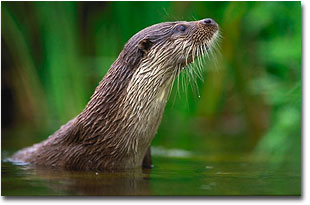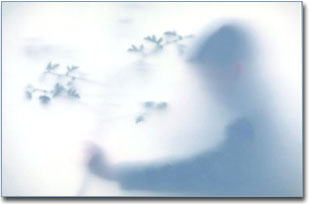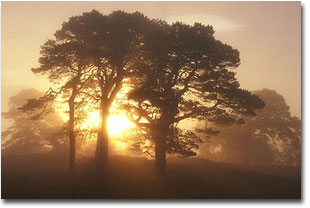|
|
 Creativity and Addiction
Text and photography Copyright Niall Benvie
By modern standards of “normal” behaviour, spending hours or days in a hide on land or in water, waiting for a bird or mammal to appear, is considered somewhat eccentric. It is the sort of revelation that, in most companies, is likely to attract an expression of awe, immediately followed by a puzzled silence. “You must have a lot of patience” is a popular get-out move, to which the right response, in my case at least is, “No, I’m just stubborn”. It”s not usually worth trying to explain why hide time not only makes sense but why, from our perspective as wildlife photographers, we often feel compelled to do it. The reasons we take ourselves to these peripheries of “reasonable” behaviour are as numerous as there are those of us willing to do it. Sometimes, they may simply be financial, sometimes the resulting kudos provides a motive. There may be a desire to see and photograph what no other person has ever witnessed or, most commendable of all, a simple desire to honour the subject through photography. But whatever the motivation, the moving force is creativity and in some, the urge to create can be as powerful as any of our other “basic instincts”. I get a recurring dream of arriving at the end of my life and, instead of all its events flashing before my eyes, I see all the photographs I’ve missed: the time when I framed up the perfect falls, but no salmon leapt; the occasion when an extraordinary double rainbow at dusk had to go in the bin because I failed to focus my rangefinder; the way a seal looked at me from the water just when the autofocus failed.
Those of us who find it too expensive, or choose, to do most of our work away from the wildlife hotspots of the world can find our diet pretty lean, unless we put in a lot of time and work researching sites and waiting (in that hide) to see if anything appears. Pictures come slowly; experiences are hard won. I believe, however (as one with a deeply ingrained Presbyterian sensibility would), that this is the best training possible for when we go to pig out in Yellowstone or Florida. It is easier to appreciate just how spectacular these places are (if over-worked) when you may shoot more rolls of mammals or shorebirds in a week than you do in a year at home. But living on that sort of diet all the time simply demands even more spectacular encounters, if the level of creative satisfaction is to be maintained. Here, I think we can draw parallels with people who take part in extreme sports, such as canyoning, base jumping or skeleton bobsleigh (if sitting face down a few inches off the ice on a tea tray as you hurtle down an ice run isn’t extreme, I don’t know what is). “We have strong evidence that the feelings of being elated and excited because you are moving toward achieving an important goal are biochemically based, though they can be modified through experience”, comments Professor Richard Depue of Cornell University’s Laboratory of the Neurobiology of Personality and Emotion. He believes that differing levels of, or sensitivity to, the neurotransmitter dopamine goes a long way to accounting for the fact some individuals are highly motivated - or “incentive-reward” driven, while others are less focused on particular goals. What drives extreme sports participants and perhaps also those people with a highly developed creative drive is the need to experience the sensation associated with the stimulation of the dopamine system.
A further twist is added by another neurotransmitter, serotonin, often referred to in the context of Seasonal Affective Disorder or “winter blues”. In that disorder, reduced levels or activity of serotonin (stimulated in part by the hypothalamus's reaction to short days and darkness) can lead to people being more irritable and volatile than usual. At these times, the response to dopamine is heightened. Reviewing my collection, the majority of my favourite pictures have been taken in the winter months. That may be simply because I like the colours and look of winter, but it could also be because the effect of these pictures when I first saw them was more powerful than when I shot a satisfying picture the following summer. How marvellous it is to have labels. Every winter, I used to think that I was just miserable chiel, moping around like one of Joanne Rowling’s dementors between photo shoots. Now I can characterise myself as ”serotonally deprived”. The endless pursuit of new images isn’t just because I need to make a living. No, it’s because I am a martyr to my dopamine system. The best treatment is perhaps to go somewhere warm and sunny with lots of approachable mammals. But no, that would offend my Presbyterian instincts too deeply, I think. I’ll just stay at home and try to get off the dopamine. Creativity, after all, is also about finding new solutions to old problems. Note: Literature on the link between creativity and the dopamine system is hard to find, so if there are any real psychiatrists reading this, I’d be pleased to hear your ideas- niall@niallbenvie.com Niall Benvie - NPN 018 Comments on this article? Send them to the editor. |
|
|
 Having photographed European otters under controlled conditions
at different times of the year in the Netherlands, I know that anything I
get now of wild ones will have a hard job providing the same visual
satisfaction. It’s a rich diet, however and in terms of the experience and
the relative excitement of each, nothing compares with the wild.
Having photographed European otters under controlled conditions
at different times of the year in the Netherlands, I know that anything I
get now of wild ones will have a hard job providing the same visual
satisfaction. It’s a rich diet, however and in terms of the experience and
the relative excitement of each, nothing compares with the wild.
 Novel approaches to old themes - here, a boy planting a tree - provide a
creative lift and, if the pictures work on a personal level, an incentive to
experiment further. Without experimentation and the possibility of
discovering a new field of visual interest, I find it hard to sustain
interest; formulae are safe and commercially sound but don’t contribute to
the long term development of a personal vision of the world.
Novel approaches to old themes - here, a boy planting a tree - provide a
creative lift and, if the pictures work on a personal level, an incentive to
experiment further. Without experimentation and the possibility of
discovering a new field of visual interest, I find it hard to sustain
interest; formulae are safe and commercially sound but don’t contribute to
the long term development of a personal vision of the world.
 I have re-shot this wood in so many conditions, some absolutely perfect,
that the buzz of working the place has gone. I am copying myself.
I have re-shot this wood in so many conditions, some absolutely perfect,
that the buzz of working the place has gone. I am copying myself.